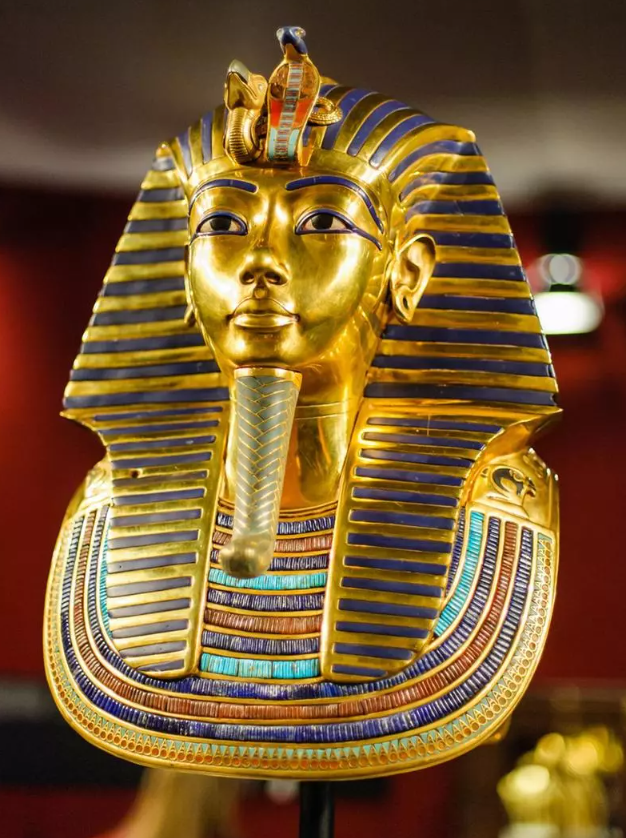
Grand Egyptian Museum, Located on the Giza Plateau, the Grand Egyptian Museum is a stunning masterpiece that allows you to see more than 100,000 artifacts up close. Construction began in 2002, following an international architectural competition to design a new museum housing valuable Egyptian archaeological discoveries.
It is a world of divine creations, combining pure magic and wonder, showcasing an artistic awakening, mythological beliefs, and historical development.
It demonstrates the skills and creativity of the ancient Egyptians, encompassing many great civilizations. It reflects the skills and creativity of modern Egyptians, designed to suit this era of progress and sophistication. As promised, it includes numerous rooms containing unique and distinctive pieces. The most important of these rooms is the room of King Tutankhamun and his belongings.
King Tutankhamun will remain the hero of the Grand Egyptian Museum, where his 5,537 artifacts are being displayed in full for the first time since the tomb’s discovery in 1922. He explained that the tomb was discovered almost intact after being covered by the earth from the excavation of Ramses VI’s tomb, thus escaping theft.

He pointed out that Tutankhamun was not a king with widespread political influence like Ramses II or Thutmose III, but he became the most famous king in archaeological history thanks to the completeness of his tomb, the “curse of the pharaohs” that accompanied it, and the myths that surrounded its discovery. He added that this discovery was the most important archaeological event of the twentieth century and made Howard Carter a global icon in archaeology.
There are also many other great artifacts, as the new museum houses more than57,000 artifacts from kings and queens.
The artifacts on display in the museum date back to prehistoric times through the Greek and Roman eras.
The idea of establishing a museum of Egyptian antiquities in Egypt dates back to Muhammad Ali Pasha, the ruler of Egypt (1805–1848). He issued a decree on August 15, 1835, in an attempt to halt the export of antiquities from Egypt. This decree resulted in the establishment of the first Egyptian Museum of Antiquities in Cairo, located in a building near Azbakeya Gardens.
The script for the exhibition was designed by Hekikian Effendi, and Youssef Diaa Effendi assumed management of the museum. At the same time, Sheikh Rifa’a al-Tahtawi, the official responsible for excavating and preserving Egyptian antiquities, ordered that no further excavations be conducted without his permission. He also declared that the export of antiquities from Egypt was strictly prohibited, and that all discoveries would be transferred to the Azbakeya Museum.
The entire collection of artifacts was transferred from Azbakeya to a hall within the Saladin Citadel during the reign of Abbas I in 1851. Visits were limited to a select few distinguished visitors. In 1854, during his visit to Egypt, the Austrian Crown Prince Maximilian visited the Azbakeya Museum and showed great interest in the collection. The ruler of Egypt at that time gifted him most of this collection, which now represents a significant portion of the ancient Egyptian antiquities collection at the Kunsthistorisches Museum in Vienna.Unique pieces in the Grand Egyptian Museum
Wooden Gilded arm-shaped incense burner, consisting of a handle with head of falcon end with a hand extended with a vase
All these things demonstrate the diversity and ingenuity of the ancient Egyptians, and all these things are found in one place, which is the Grand Egyptian Museum.
The Grand Egyptian Museum… Egypt’s gift to the world.
The Grand Egyptian Museum is not just an antiquities exhibition; it is an integrated scientific and cultural center that aims to enhance awareness of human heritage, support research and education, and attract cultural tourism to Egypt.
UNESCO noted that the Grand Egyptian Museum will offer foreign and Egyptian visitors a unique opportunity to explore more than 5,000 years of ancient Egyptian history.
The building, with an area of more than 480,000 square meters, is about to open its doors and will become the largest museum in the world housing the treasures of ancient Egypt.
Choosing Grand Egyptian Museum Tours in 2026 ensures travelers a seamless and enriching journey through Egypt’s most anticipated cultural landmark. With exclusive access to world-class collections, including the King Tutankhamun Exhibition at GEM, along with expert-guided explanations and convenient services, these tours provide the perfect balance of history, comfort, and discovery. Whether you opt for a private tour of the Grand Egyptian Museum or join a small group experience, your visit will be unforgettable—bringing you closer than ever to the wonders of ancient Egypt.
Your visit will include the King Tutankhamun Halls, the main exhibition halls, the Grand Lobby, the Grand Staircase, the Khufu Boat Museum, the commercial area, and the outdoor gardens, for an exceptional experience that combines ancient history with the splendor of contemporary design.
to suit technological progress.